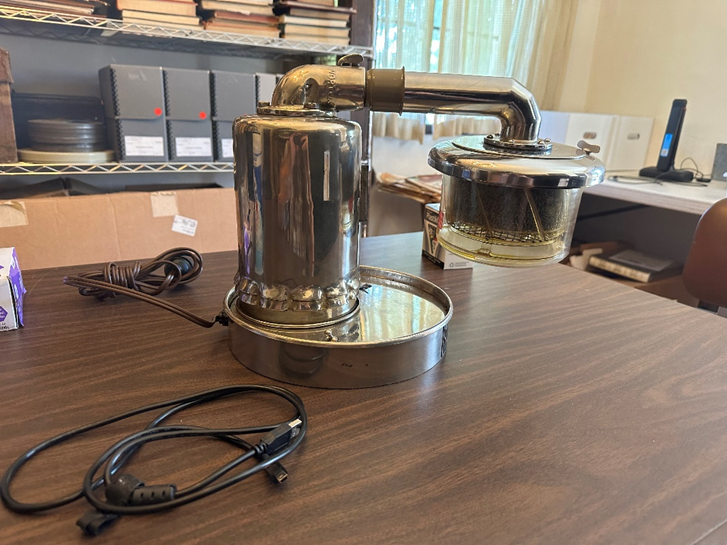#6 “Vortox Oil Bath Air Cleaner”-Vortox Collections
May 2024
#6 “Vortox Oil Bath Air Cleaner”-Vortox Collections
By Cooper Crane
Artifact Description: Vortox Company Oil Bath Air Cleaner and Vortex Chamber Body. Stainless steel design with saddle bracket attachment, used to clean dust and debris from intake air for industrial equipment.
We discussed last week in our previous post, the role of the citrus industry in Claremont’s development, and how citrus orchards transformed the local environment and economy. We discussed the social effects of the citrus industry and the labor force, namely Mexican Americans who kept Orchard Heaters fueled to protect citrus from the cold weather. Today we will be talking about one of the few manufacturing companies that existed in Claremont, one that is central to the history of Claremont itself, and to Claremont Heritage.
In 1918, Herman Garner filed a patent for an air cleaner design in the city of Pomona. After graduating from Pomona College in 1906 and the Sibley College of Engineering at Cornell University, he briefly worked as a draftsman for the Pomona Manufacturing Company, designing and building tractors. After designing a new kind of air cleaner, he went independent, filing his patent and starting the Pomona Air Cleaner company before moving to Claremont in late 1927. Garner’s patent was for an oil air bath cleaner, designed to clean air from dust and particulates before it is passed to the carburetor of a vehicle for fuel-air mixing. Garner designed his invention after noting the problem of engine cylinder scaring on tractors after prolonged use: the damage was caused by the engine burning accumulating sand and dust. Garner renamed the Pomona Air Cleaner Company to Vortox, after their most successful product. He named his oil bath air cleaners Vortox, for the observed resemblance to air vortexes in which dust would become trapped. The name stuck with the company as it became shortform for the powerful cleaning ability of the oil bath design.
In his design, Garner addressed a very specific and important demand in the increasingly competitive citrus market in Southern California in the 1920s and 1930s. As the demand for citrus products grew into an international market, even seemingly minor advantages, like those offered by the Garner oil bath air cleaner, could make a difference in productivity and give a competitive edge in the market, as well as an increased ability to respond to the growing demand. Garner’s company quickly became successful and allowed him to become a prominent community member. The success of his company funded the construction of the Garner residence in Memorial Park (where Claremont Heritage resides), the Padua Hills Theater, and helped sponsored the Padua Hills Mexican Players.
Garner’s invention led to one of Claremont’s most important and arguably most prominent manufacturing companies. Garner’s design was used in agricultural equipment across the country and was installed on almost every vehicle model available including International Harvester, Caterpillar, John-Deer, Allis-Chalmers, Cleveland Tractor, and Case. (Stuhr Museum, 2019.) The basic function of Garner’s cleaner uses an open inlet, which first forces air vertically toward an oil reservoir before being forced in an abrupt change in direction. The change in direction removes dust particles which are forced to the outside of the reservoir walls and are trapped in the oil reservoir. An additional filter mesh can remove additional particulate matter by trapping dust and dirt inside of a wire mesh, while allowing air to pass clearly. While Spanish Moss (Tillandsia usneodies) was used as the original filter element, Vortox designed a machine which could quickly produce crimped steel wire in 1940. Claremont Hertiage’s personal machine uses both of these methods in combination with a connection manifold that allows air to pass between the two cleaners.
A diagram of the working principle of a Garner Vortox oil air bath cleaner. (Claremont Hertiage Vortox Collections)
During the Second World War, a more complex version of Garner’s design would be modified for use in tanks, proving absolutely essential in their use in the deserts of North Africa. Garner’s cleaners would be shipped internationally to England, Italy, Denmark, and Australia, and post-war, would form the foundation of filtration standards for the automotive industry until the 1960s. Vortox air cleaners became so instrumental to the war effort that workers who worked at the Garner factory in Claremont were considered exempt from the wartime draft. (Robert [Bob] Bolinger, 2004.) At its peak, Vortox employed more than 150 workers and made more than 90,000 dollars a month in creating cleaners for the war effort. (Time, 1942.)
Oil bath air cleaners are no longer used in regular cars or road vehicles as they have been largely replaced by air paper filters which are cheaper and easier to replace. They are still, however, used in large semi-trucks, tractors, or other utility vehicles in which the dust load is very high and the need for filtering is absolutely essential. These oil bath air cleaners need to be cleaned at least once a day, and in extreme cases several times a day. The use of oil bath air cleaners declined with the advent of cotton and paper fiber air filters due the development of increasingly car-centric infrastructure. As dirt roads were gradually replaced with paved, asphalted roads, the amount of road dust decreased, and reduced the burden on the simpler filter designs.
Nevertheless, the Vortox Corporation still continues to produce these filters, but they have since moved out of their historic factory along Claremont’s Indian Hill Boulevard. Today, the Vortox factory and Garner Industries are awaiting conversion into commercial space for a planned Claremont South Village, which will build new apartments and transit-oriented developments near the Metrolink San Bernadino Line and future Metro Gold Line. Much like Claremont’s Packing House, the former Vortox factory seems set to live a second life in the new urban developments in Claremont’s village.
Vortox’s factory in Claremont provided jobs and opportunities for many. The building itself was designed by Los Angeles architect Arthur Munson in the Spanish revival style, much like the Garner house, and was built by Claremont builder Clarence Stover. (Cooper Crane, 2024)
-----------------------------------------------------------------------------------------------------------------------------
Acknowledgements:
A History of Claremont in 100 Objects is a blog series presented by Claremont Heritage and written and contributed to by its members. Based on the podcast A History of the World in 100 objects by the BBC and the British Museum, presented by former British Museum director Neil MacGregor. A History of Claremont in 100 Objects explores Claremont history through its material cultural legacies, placing objects important to the history and development of Claremont in larger relation to US and World History
About the author:
My name is Cooper Crane. I am an archival intern with Claremont Heritage. I study history and anthropology with an emphasis on archaeology and the history of empire and environmental history at Pomona College in Claremont. I was born in Anaheim and have lived my whole life in Corona California, a city with a similar shared history to Claremont. I have degrees in history, anthropology and political science from Norco College California and am a certified California Climate Steward through the University of California Department of Natural and Agricultural Resources. I write to explore history through the material objects of history, and by exploring the elements of history that are unwritten. My current work at Claremont Heritage includes the curation of artifacts on display at the Garner House and the Claremont Packing House, the creation of artifact descriptions for our archives and contributing to A History of Claremont in 100 Objects.
Citations:
Bolinger, Robert. “Robert (Bob) Bolinger Interview.” Claremont Heritage Oral Histories. Ginger Eliot, Interviewer. May 4, 2004.’
Garner, Herman. “Air Cleaner.” U.S. Patent 1,423,412. Sept 20, 1918.
Neiuber, John. “The Garner Legacy: The Architecture.” Claremont Courier. Nov 3, 2017.
Stuhr Museum of the Prairie Pioneer. “1930 McCormick-Deering Farmall Tractor.” Stuhr Museum of the Prairie Pioneer’s Tractors. 2019.
Time Magazine, “Business: Vortox” Time Magazine. Nov 23, 1942.










Comments
Post a Comment